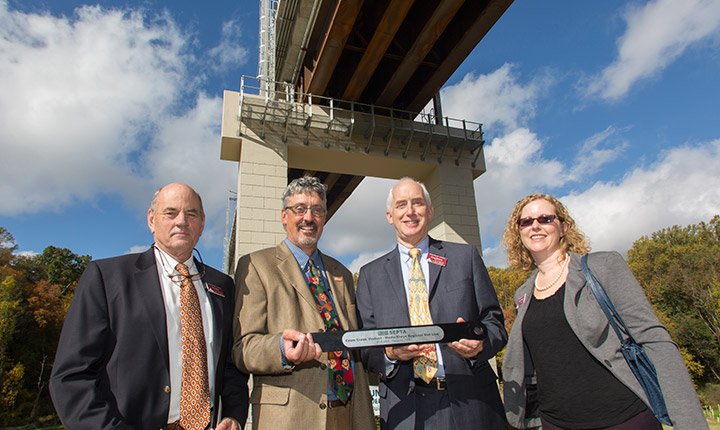Swarthmore, SEPTA Celebrate Completion of Crum Creek Viaduct

From left: Vice President for Facilities and Capital Projects Stu Hain, Swarthmore Borough Mayor Tim Kearney, Vice President for Finance and Administration Greg Brown, and Special Assistant to the President Susan Eager.
Members of the College community on Friday joined representatives from SEPTA, local elected officials, and community leaders to celebrate the completion of the Crum Creek Viaduct project, and to stress their commitment to the natural restoration of the area.
Known locally as the Trestle, the 120-year-old Crum Creek Viaduct had reached the end of its useful life and required replacement to ensure safe and efficient rail service for riders of the Media/Elwyn line. Standing beneath the new structure Friday, officials unveiled a commemorative plaque that is mounted on a bridge column above the Crum Creek.
Construction on the 925-foot long, 100-foot-high bridge began in the winter of 2015 and ended on time this fall. The new steel and concrete structure is designed to last 100 years.
The project required closure of the bridge for 11 weeks this past summer, and discontinuing SEPTA rail service beyond the Swarthmore station. SEPTA also had to remove many bushes and trees to create service access to the site.
“Knowing how important the Media/Elwyn Line is to the economic vitality of our region, we worked closely with SEPTA to assure that the project would be successful, with particular sensitivity to the long-term viability of the Crum Woods," says Greg Brown, vice president for finance and administration. "SEPTA was responsive to our concerns, and while there is considerable work ahead, we believe we are well on our way toward remediating the impact to the woods caused by the project.”
“Swarthmore College was very helpful throughout the construction project,” adds Joe Connolly, a government affairs official at SEPTA. “Students, staff, and faculty were very patient.”
As soon as rail service resumed in September, SEPTA crews began work to restore the project site. Crews have reopened the Leiper-Smedley trail and public access to trails below the Crum Creek Viaduct. Working closely with staff from the College and the Scott Arboretum, crews have graded the eastern and western slopes along the sides of the bridge abutments and seeded and planted more than 5,000 native shrubs and trees.
The area of the meadow known as Crumhenge, whose unique stone slabs were appreciated for decades, was removed during construction but recently reinstalled. Wetland restoration work is ongoing, as part of SEPTA’s responsibility to restore and maintain the area.
The College can soon begin the restoration planting on the right of way of the sanitary sewer line, which SEPTA had been using as an access to the project site, says Jeff Jabco, director of grounds and Scott Arboretum coordinator of horticulture.
“Our goal is to replant all disturbed area and care for the areas of the Crum Woods that were impacted,” he says.
"Our staff and volunteers will now work to assist mother nature in restoring the natural beauty of this area disturbed in the construction process," adds Claire Sawyers, director of the Scott Arboretum. "The Crum Woods is not only a special part of the Scott Arboretum and the Swarthmore College student experience, it represents one of the largest remaining natural areas in Delaware County. So we feel a responsibility to steward the valley for the whole community as an example of gorgeous wild Pennsylvania woodland."


